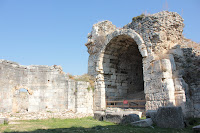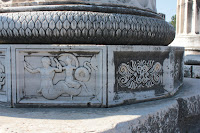Today we visited three cities of ruins: Priene, Miletos, and Didyma. They were all different and very memorable. From our hotel in Kusadasi, we were picked up and drove to the first site, Priene.
Priene is a city built on top of a hill in 400BC. At that time, the surrounding flat country-side was water, so in reality the city was built near a harbor area. But over time erosion deposited silt and soil and filled in the area between mountains. Now there are farms and small villages in the area.
Priene began as an independent, Ionian Greek city-state in the 4th C BC, and was conquered by Alexander the Great, the Persians, then the Romans (who became the Byzantines), and finally was abandoned around 1100AD. The most prominent parts of the ruins are the temple of Athena, with five columns still standing, the theater, a gymnasium that was converted into a Basilica during Byzantine times, and the main street with ruins of houses. The city is surrounded by a wall with an acropolis looming over the city. Apparently only 2% of the ruins have been excavated.
View of the acropolis
Amphitheater
Backstage and a VIP seat at the theater
Gymnasium that was turned into a basilica
Temple of Athena
The city was constructed in a grid pattern and used terracotta pipes for sewage systems and heating systems. It's incredible to look out at the surrounding countryside and think it used to be water, and that this marble city flourished on top of such a big hill.
Looking out beyond the temple
Ruins of houses and another temple
Miletus was the next ruins we visited. As you drive up to the location, you notice a large stone wall. When you finally arrive, you can see that it's actually the backside of a giant amphitheater that has been excavated. According to wikipedia, Miletus existed as far back as Neolithic time, with an actual settlement in the Late Bronze Age. It became an Ionian city-state in the 8th C BC, but was destroyed when the Persians came. The current ruins are from the Roman time, in early 100 AD. The most prominent sites include the aforementioned amphitheater, and the Roman baths built for Marcus Aurelius' wife. There are various other buildings that have been excavated, but like Priene most of it has yet to be uncovered.
The baths are incredibly interesting; it could house up to 1000 people at a time. The entryway leads to the pools, where a lion fountain would bring water. This leads to the changing rooms which would've been covered head to foot with marble.
The baths
The pool area
Changing rooms
Entry to the baths
The amphitheater originally seated 4,500 people, but was expanded to 15,000 as the city grew. The stage was raised, and in the sunken center would be musicians and dancers. Behind the amphitheater were galleries where the public could walk. Behind the amphitheater was the boat dock, customs house, sporting ground, and market area. We didn't go there, possibly because it's still under excavation.
The amphitheater
Looking down from the top
Passages in the back of the theater
Bottom of the theater
Behind the theater - dock house and customs house
Carvings of a hunt
The final city we visited was Didyma, which is actually just a giant temple of Apollo that was unearthed in the 1800s. In 300 BC, when Alexander the Great conquered this area, he wanted Didyma to be rebuilt for the god Apollo; it had previously been destroyed by the Persians. It was never finished, however, and if it were finished it would've been the largest in the world. There is evidence at the site that it was never finished; columns are left uncarved, friezes unfinished.
What remains, however, is amazing! The columns are huge, the finished carvings are beautiful, and it's just such a fun place to explore. In the back of the temple was the oracle's house; there used to be a carbon monoxide well there, so when the priests would ask her a question, she'd “inhale Apollo's spirit” and give an answer.
Temple of Apollo
So many ruins!!


































No comments:
Post a Comment